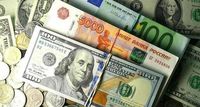As of April 7, 2025, the currency landscape in Kyrgyzstan has seen notable shifts, with the official exchange rates for the US dollar and Russian ruble rising, while the euro and Kazakh tenge experienced slight declines. The National Bank of the Kyrgyz Republic reported that the official exchange rate for the US dollar stands at 86.7688 soms, reflecting a modest increase of 0.07 percent. In contrast, the euro's official rate is now 95.3806 soms, marking a decrease of 0.08 percent.
The average exchange rates in Bishkek's exchange offices over the last two hours have also shown these trends. For the US dollar, the buying rate is 86.59 soms and the selling rate is 87.06 soms. Meanwhile, for the euro, the buying rate is 94.8 soms and the selling rate is 95.75 soms.
Turning to the Russian ruble, its official exchange rate is currently 1.0321 soms, which is an increase of 0.16 percent. The average rates in exchange offices reflect a buying price of 1.006 soms and a selling price of 1.038 soms. Conversely, the Kazakh tenge has seen its official rate drop to 0.1722 soms, down by 0.41 percent, with exchange office averages showing a buying rate of 0.1175 soms and a selling rate of 0.1875 soms.
The Chinese yuan, however, has strengthened, with its official exchange rate recorded at 11.9154 soms, an increase of 0.34 percent. In exchange offices, the average buying rate is 11.8 soms and the selling rate is 12.2 soms.
Looking ahead, analysts predict that from April 7 to April 13, 2025, there may be further rises in the dollar, euro, and yuan against the ruble, provided there are no significant increases in oil prices or improvements in the geopolitical situation. Dmitry Babin, an expert from BCS Mir Investments, indicated that last week the ruble had strengthened after hitting a two-month low against the yuan. This strengthening was attributed to a continued influx of foreign investment into ruble-denominated assets, particularly government bonds (OFZs), which offer yields that significantly exceed interest rates on loans in other currencies.
Babin elaborated on the carry trade strategy, where funds borrowed in currencies like the yuan at low rates are sold for rubles to purchase higher-yielding bonds. However, he cautioned that this strategy carries risks, particularly concerning potential losses from significant currency devaluations. He noted, "In our case, this is the risk of the ruble's devaluation, which intensified at the end of the trading week as oil prices began to decline sharply due to new tariffs imposed by President Donald Trump against nearly all countries worldwide." This decline in oil prices has led to a drop of over 7%, reaching four-year lows.
As a result of these market dynamics, the ruble's value has faced downward pressure, erasing gains made earlier in the week. Babin suggested that the dollar could rise above 88 rubles, and the euro could exceed 97 rubles if the euro-dollar pair remains around its current level of 1.1. He also projected that the yuan could approach 12 rubles, assuming the dollar-yuan pair stays near the current value of 7.35.
In the Forex market, the ruble has seen a decline of 2.19% against the dollar and 2.81% against the euro. As of this writing, the dollar exchange rate is 86.35 rubles, while the euro has risen to 95.17 rubles. An expert from BCS Express, Mikhail Zel'tser, noted that the current support for the ruble comes from a significant inflow of currency from Russian exporters, among other factors. However, he warned that this support is not expected to last indefinitely.
Zel'tser pointed out that last week, futures for the dollar and euro were nearly two percent higher than the official rates set by the Bank of Russia, suggesting that these currencies might continue to rise in the near future. He also indicated that an increase in the ruble's exchange rate is anticipated by approximately two percent on April 8, 2025.
As the currency market continues to fluctuate, it will be crucial for investors and consumers alike to monitor these changes closely. The interplay of global economic factors, domestic monetary policies, and geopolitical developments will undoubtedly shape the direction of currency values in the coming weeks.






